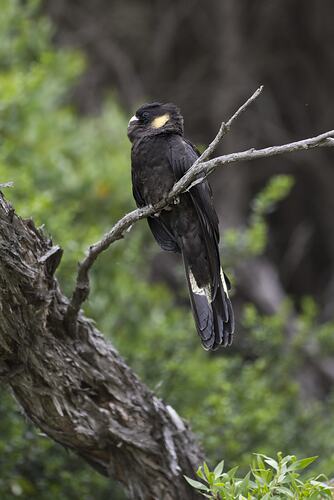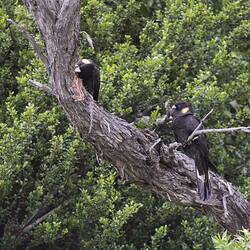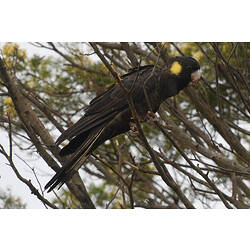General Description
Body black with yellow patches on the ear (larger in females than males), tail and edges of feathers. Bill dark grey (males) or light grey (females). Circle around the eye pink (males) or dark grey (females). Bill to tail length up to 65 cm.
Biology
Yellow-tailed Black-cockatoos feed in small to large flocks, eating seeds from native trees and pinecones as well as insects and grubs that live in logs and trees. Flocks consisting of hundreds of birds can be seen throughout autumn and winter as they move to lower-lying areas. They nest within large tree hollows lined with wood chips or decayed debris which are prepared by both parents. Females typically incubate two eggs and are fed by the male during this time. Only one chick usually survives, staying with its parents for six months. These cockatoos have a harsh, penetrating call and flocks can sound like they are 'chuckling' when flying. Yellow-tailed Black-cockatoos are experiencing population declines throughout their range but locally large populations remain in some areas such as the Gippsland Lakes.
Distribution
South-eastern mainland Australia and Tasmania.
Habitat
Wet forests, woodlands and pine forests.
More Information
-
Animal Type
-
Animal SubType
-
Brief Id
A large black cockatoo with yellow ear patches and tail panels. Flies with slow, deep wingbeats.
-
Colours
Black, Yellow
-
Maximum Size
65 cm
-
Habitats
-
Diet
Omnivore
-
Diet Categories
Insects, Invertebrates, Seeds
-
Endemicity
-
Commercial
No
-
Conservation Statuses
CITES: Trade restrictions (Appendix II), FFG Threatened List: Not listed, EPBC Act 1999: Not listed, IUCN Red List: Least Concern
-
Taxon Name
-
Common Name
Yellow-tailed Black-cockatoo
-
Kingdom
-
Phylum
-
Subphylum
-
Class
-
Order
-
Family
-
Genus
-
Species Name
funereus









